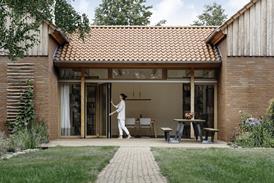Using PFI to procure hospitals has resulted in mixed results, to say the least. Many believe it hasn’t given us the hospitals that we deserve. So is ProCure 21 the answer to the problems of PFI? We ask those involved.
For consultants involved in PFI, their problems seem to start after preferred bidder stage. Everything is done to ensure the bid measures up to the requirements of the brief, but once you’re a winner that’s when problems can begin as cost cutting goes into overdrive.
Carl McKenzie, building services engineering director at BDP says: “Once you get past preferred bidder and into design there can be a tendency for contractors to want to “value engineer” a lot of aspects. I wouldn’t say capital is king, but it is getting that way. If the fm guys aren’t saying the right things, the contractors could just say, ‘Worry about that later’. But there is no later, it’s at that stage that they’ve got to make an impact.”
The ‘value engineering’ stage also tends to engineer out elements of sustainability. BDP’s head of sustainability Trevor Butler says: “PFI places a requirement on the upfront design to be inherently more energy efficient and sustainable but as you go through the process you lose certain elements. There are lots of issues vying for attention at the start of a project but if you get energy efficiency built into the building form – like good daylight and cross ventilation – and you hold on to those elements, you can go a long way towards energy efficiency, but they have got to be there at day one.”
McKenzie cites the example of a PFI hospital which BDP has been involved in. This has worked well, because there are elements of a more partnering-style (though not contractual) approach. “This particular PFI has gone well because we’ve had the specialist sub contractors on board for six months so they understand what we’re doing in terms of design. They have been able suggest how they would go about procuring or installing.” Also, financial cost checks have been minimised. “This has only been the case because we’ve concentrated on supply chain partners and have worked with them for many months before we actually needed to have them on board. That isn’t the norm in a lot of other PFIs.”
This leads neatly to ProCure 21 which embraces the theories of a partnering approach and makes them an integral part of the construction process. Barry Hyam, ProCure21 framework director for Haden Young says: “From our perspective ProCure 21 is excellent because it encourages early involvement of the m&e services installers. The value of this shouldn’t be underestimated.”
Hyam is adamant that the teamwork resulting from the partnering arrangement does generate an improved product and an improved service throughout both the design and build process. Issues such as buildability, choice of material, construction method – including the emphasis on off-site manufacturing – and servicing solutions can be picked up at those critical first stages of design.
Inevitably there is pressure on contractors, in conjunction with the Principal Supply Chain Partners (PSCPs), early in the process to firm up a target price. But does ProCure21 squeeze costs and time?
The simple answer is yes, says Hyam and that is the intent of ProCure21. “It encourages best value and it also allows the sharing of lessons learned on both design and installation and that will result in cost savings. We’re able to make best use of the pre-construction period as a result of early involvement and off-site manufacture can commence early, again an improvement in program. ”
BDP’s McKenzie agrees with this view: “In ProCure 21 the trust is declaring with its supply chain partners the levels of profits up front as its an open partnering agreement, so the pressures on the contractors to ‘value engineer’ are not as great as in a PFI because they know the margin they are going to make at the end of the job. There’s no point in trying to whittle things down, which you still have in the PFI process.”
Hospitals though are about more than the first few years of construction and use. They are long term projects. Whether capital savings come at the expense of whole life cycle costs depends on the approach taken by the particular NHS Trust involved: “It’s a key issue because it is the most appropriate definition of best value,” says Hyam. “Our role within the PSCP team is to provide advice to the Trust for it to make decisions as to whether a price premium on an element of the installation would be cost-effective in the medium and long term.”
This is where good communication with the client is vital. Even if an NHS Trust opts for ProCure21 it doesn’t mean the client understands whole life costs any more than a commercial client. The ethos of ProCure21 is that collaboration and teamwork doesn’t only sit within the PSCP teams but actually starts with the client. This can help with rapid decision making, something that hasn’t always been forthcoming in the past.
The benefits come when appropriate NHS Trust staff are empowered to make timely decisions as part of the project team, whether it’s defining the brief or the content of the services. “That adds enormously to the efficiency of the process,” says Hyam. “And allows the benefit to accrue to the construction of the project.”
From Hyam’s point of view, simple ideas are best in the long run. Hospital buildings need to be flexible if they are to serve patients for many years. Modular building services can contribute to easy dismantling.
Haden Young has held a series of initiatives with its supply chain to find improvements in modularisation. This focused on off-site manufacturing, in particular bedhead trunking units and medical gases. “It really covers all aspects of the integration of the various products into a co-ordinated package and involves collaboration between multiple parties in order to create a single module. Bedhead trunking is a good example because there are so many services built in, if this is done off-site it not only creates an integrated product that is helpful in use but it creates a much quicker installation. And that is what ProCure21 positively encourages.”
If there is one area of ProCure21 that could be improved it is a clearer understanding of future workload so that the industry could plan resources accordingly. “We are aware of forward leads and NHS Estates has a plan of forward leads but it would be better to see ever more detail available,” says Hyam.
ProCure21 is still in relatively early stages. NHS Trusts aren’t obliged to take this route to procurement, and some are sticking with straightforward PFI which means that construction companies will probably be faced with the situation of working in both types of project over the next decade. However, there seems to be trend towards ProCure21.
Carl McKenzie comments: “What’s interesting is that the scale of the projects is changing on ProCure 21. Not that long ago it was up to £25 million maximum but now £40 million is being advertised and there’s talk of it going up to £100 million. I think the trusts have seen that it’s a less adversarial approach and that teams are able to handle bigger projects in a more open environment.”
Source
�ǿմ�ý Sustainable Design




















No comments yet